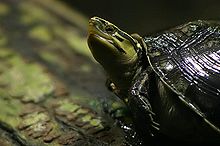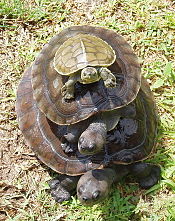Asian box turtle
| Asian box turtle | |
|---|---|

| |
| Amboina box turtle, Cuora amboinensis | |
| Scientific classification | |
| Domain: | Eukaryota |
| Kingdom: | Animalia |
| Phylum: | Chordata |
| Class: | Reptilia |
| Order: | Testudines |
| Suborder: | Cryptodira |
| Superfamily: | Testudinoidea |
| Family: | Geoemydidae |
| Subfamily: | Geoemydinae |
| Genus: | Cuora Gray, 1856 |
| Species | |
|
About 12 | |
| Synonyms | |
| |
Asian box turtles are turtles of the genus Cuora in the family Geoemydidae. About 12 extant species are recognized.[1] The keeled box turtle (Pyxidea mouhotii syn. Cuora mouhotii) is often included in this genus, or separated in the monotypic genus Pyxidea. Genus Cuora is distributed from China to Indonesia and the Philippines, throughout mainland Southeast Asia, and into northern India and Bhutan.[1]
Description
Cuora species are characterized by a low- (e.g. Cuora pani) to high- (e.g. Cuora picturata) domed shell, which usually has three keels on the carapace. They are reddish, yellowish, brown, grey, and/or black in color. Some species have bright yellow, black, orange, or white stripes down the length of their keels. Their body color is highly variable, but usually very intense. Most species show stripes of variable color down either side of their heads, which usually meet at the nose.
Background
Asian box turtles are the most heavily trafficked turtles in the world. They are captured and sold as food to China, and to the United States as pets. Nancy Karraker, a University of Rhode Island associate professor, has said "Trafficking in turtles is a major issue in Southeast Asia, and it's important that we understand the key ecological roles that species like this box turtle play before it's too late,"[2]
Different conservation organizations are taking action to prevent or slow down the extinction of these species, but in the past, most of the efforts failed due to lack of biological research regarding the history or genetic diversity of these species.[3]
Behavior
Asian box turtles are terrestrial, semiaquatic, or mainly aquatic, most spending much of their time on the edge of shallow swamps, streams, or ponds that are dense with vegetation. Most are omnivorous, but carnivores do occur.

Cuora amboinensis amboinensis (Sulawesi), Cuora amboinensis kamaroma (Thailand), Cuora amboinensis ssp. (unknown), Cuora amboinensis ssp. (Philippines); Cuora trifasciata (Guangdong, China), Cuora aurocapitata (Anhui, China), Cuora pani pani (Shaanxi, China), Cuora yunnanensis (Yunnan, China); Cuora cyclornata cyclornata (Annam, central Vietnam), Cuora cyclornata meieri (north Vietnam), Cuora mccordi (Guangxi, China), Cuora zhoui (unknown); Cuora flavomarginata sinensis (Sichuan, China), Cuora flavomarginata evelynae (Ryukyu Islands, Japan), Cuora flavomarginata flavomarginata (Taiwan), Cuora picturata (southern Annam, south Vietnam); Cuora galbinifrons galbinifrons (north Vietnam), Cuora galbinifrons galbinifrons (Hainan, China); Cuora bourreti (Annam, central Vietnam), Cuora bourreti (Laos); Cuora cyclornata cyclornata × Cuora amboinensis kamaroma hybrid, Cuora cyclornata × Pyxidea mouhotii, Cuora trifasciata × Pyxidea mouhotii, Cuora galbinifrons × Pyxidea mouhotii = "Cuora serrata"
Taxonomy and systematics
Listed alphabetically by binomial name, the species are:[4]
- Amboina box turtle or Southeast Asian box turtle, C. amboinensis (four subspecies)
- Wallacean box turtle, C. a. amboinensis
- West Indonesian box turtle, C. a. couro
- Malayan box turtle or domed Malayan box turtle, C. a. kamaroma
- Burmese box turtle, C. a. lineata
- Yellow-headed box turtle or golden-headed box turtle, Cuora aurocapitata or C. (pani) aurocapitata[Note 1]
- Bourret's box turtle, C. bourreti
- †Cuora chiangmuanensis[7] (Late Miocene of Thailand)
- Vietnamese three-striped box turtle or green rice turtle, Cuora cyclornata (three subspecies)
- Chinese box turtle, yellow-margined box turtle, or golden-headed turtle, C. flavomarginata (two subspecies)
- Indochinese box turtle, Vietnamese box turtle or flowerback box turtle, C. galbinifrons
- McCord's box turtle, C. mccordi
- †Cuora miyatai[8] (Middle Pleistocene of Japan)
- Keeled box turtle, C. mouhotii (two subspecies)
- Pan's box turtle, C. pani = "C. chriskarannarum"
- Southern Vietnamese box turtle, C. picturata
- †Cuora pitheca[citation needed] (Late Miocene of China)
- Philippine box turtle, C. philippensis[citation needed]
- Golden coin turtle or Chinese three-striped box turtle, C. trifasciata
- †Cuora tungia[9] (Lower Pleistocene of China)
- Yunnan box turtle, C. yunnanensis - rediscovered in 2004, verified in 2007
- Zhou's box turtle, C. zhoui = "C. pallidicephala"
Cuora serrata, originally described as C. galbinifrons serrata by Iverson & Mccord[10] and later considered a distinct species[11] is a hybrid of the keeled box turtle and taxa of the Indochinese box turtle complex as shown by the genetic studies of Parham et al.[12] and Stuart & Parham (2004). A single specimen of C. serrata has been found in the wild,[13] lending credence to the possibility that other specimens arose through natural hybridization or even from wild populations. No Chinese turtle farm is known to produce C. serrata-like specimens.[14] The occurrence of wild hybrids is often regarded as "evolution in progress", a terminology and point of view that is not always accepted. It has yet to be confirmed, whether all C. serrata from the wild have originated by direct hybridization of C. mouhotii and C. galbinifrons, or also by "hybridisation" of C. serrata × C. serrata.
Unnamed hybrids of several other Cuora taxa are also known,[Note 2] as are intergeneric hybrids such as Mauremys iversoni,[15] a hybrid between Cuora trifasciata and Mauremys mutica, which is intentionally produced in Chinese turtle farms.[12]
In captivity
Wild-caught C. amboinensis specimens were frequently available in the exotic animal trade, but are getting rarer now; other species are rare to commercially extinct.
See also
Notes
- ^ Placed into subspecies status by Artner[5] and Blanck & Tang.[6]
- ^ See Vetter & Van Dijk (2006).[citation needed]
References
- ^ a b Spinks, P. Q., et al. (2012). Species boundaries and phylogenetic relationships in the critically endangered Asian box turtle genus Cuora. Molecular Phylogenetics and Evolution 63(3), 656-67.
- ^ "URI researcher: World's most heavily trafficked turtle plays vital role in Indonesia environment, economy". The University of Rhode Island.
- ^ Spinks, Phillip Q.; Shaffer, H. Bradley (2007). "Conservation phylogenetics of the Asian box turtles (Geoemydidae, Cuora): mitochondrial introgression, numts, and inferences from multiple nuclear loci". Conservation Genetics. 8 (3): 641–657. Bibcode:2007ConG....8..641S. doi:10.1007/s10592-006-9210-1. S2CID 1739485. Retrieved 2019-04-11.
- ^ Cuora. The Reptile Database
- ^ H. Artner (2004). "Haltung und Nachzucht von Pans Scharnierschildkröte Cuora pani pani Song, 1984 und der Goldkopf-Scharnierschildkröte Cuora pani aurocapitata Luo & Zong, 1988". Emys. 11 (1): 4–21.
- ^ T. Blanck & M. Tang (2005). "Ein neuer Fundort von Cuora pani Song, 1984 mit Diskussion über den taxonomischen Status von Cuora pani und Cuora aurocapitata". Sacalia. 7 (3): 16–37.
- ^ Naksri, Wilailuck; Tong, Haiyan; Lauprasert, Komsorn; Suteethorn, Varavudh; Claude, Julien (2013). "A new species of Cuora (Testudines: Geoemydidae) from the Miocene of Thailand and its evolutionary significance". Geological Magazine. 150 (5): 908–922. Bibcode:2013GeoM..150..908N. doi:10.1017/S0016756812001082. S2CID 85781762.
- ^ "Revision of the systematics of the fossil turtles from Japan". 2007.
- ^ "A revision of Testudo tungia Yeh, 1963 from the Lower Pleistocene Gigantopithecus cave, Liucheng, Guangxi Province, China" (PDF). 2013.
- ^ J. B. Iverson & W. P. McCord (1992). "A new subspecies of Cuora galbinifrons (Testudines: Batagurinae) from Hainan Island, China". Proceedings of the Biological Society of Washington. 105: 433–439.
- ^ F. J. Obst & U. Fritz (1997). "Zum taxonomischen Status von Cuora galbinifrons serrata Iverson & McCord, 1992 und Pyxidea mouhotii (Gray, 1862)". Zoologische Abhandlungen. 49 (2). Museum für Tierkunde Dresden: 261–279.
- ^ a b James Ford Parham; W. Brian Simison; Kenneth H. Kozak; Chris R. Feldman; Haitao Shi (2001). "New Chinese turtles: endangered or invalid? A reassessment of two species using mitochondrial DNA, allozyme electrophoresis and known-locality specimens". Animal Conservation. 4 (4): 357–367. Bibcode:2001AnCon...4..357P. doi:10.1017/S1367943001001421. S2CID 86757143. "Erratum". Animal Conservation. 5 (1): 86. 2002. Bibcode:2002AnCon...5...86.. doi:10.1017/S1367943002001117.
- ^ H. Shi; J. F. Parham; W. B. Simison; J. Wang; S. Gong; B. Fu (2005). "A report on the hybridization between two species of threatened Asian box turtles (Testudines: Cuora) in the wild on Hainan Island (China) with comments on the origin of C. serrata-like turtles". Amphibia-Reptilia. 26 (3): 377–381. doi:10.1163/156853805774408487.
- ^ Zhou et al. (2008)[citation needed]
- ^ Peter C. H. Pritchard & William P. McCord (1991). "A new emydid turtle from China". Herpetologica. 47 (2): 138–147. JSTOR 3892730.
Further reading
- Buskirk, J. R., et al. (2005). On the hybridisation between two distantly related Asian turtles (Testudines: Sacalia × Mauremys). Salamandra 41, 21–26.

